Applicability of indicators methods — Chromic oxide and chremogens — For determining apparent digestibility by brahman cattles (Bos Indicus)
DOI:
https://doi.org/10.11606/issn.2318-5066.v6i4p401-434Keywords:
The article has no keywords.Abstract
A trial was carried out the objectives of which were: a) to examine the applicability of the indicator methods - chromic oxide and chromogens -, for determining the apparent digestibility and, b) to study the excretion pattern of the two indicators. As experimental animals, were used young Brahman cattle (Bos indicus) that were born free on the range while the experiment was conducted in the stall. A small amount of chromic oxide was administered in gelatin capsules once daily and the animals received a ration containing concentrate and roughages - Sugar cane (Saccharum officinarum L.) and Guatemala grass (Tripsacum laxum, Nash). Fecal samples were taken at 6 A. M., noon and 6 P. M. Feces were also totally collected during 7 days of the same collection period. Chromic oxide per cent of fecal dry matter and chromogens in units per gram of roughage or feces (dry basis), were determined on all the samples. The results referring to the digestibility obtained by the chromic oxide method comparing with the conventional showed significant differences in total, noon and 6 P. M., collections periods. The pooled values from 6 A. M. and noon, at one side, and 6 A. M.,noon and 6 P. M., at the other, showed no significant differences in relation with the conventional. In spite of the fact that a reduced number of chromogens units was found in the roughages and fecal samples, the results obtained with this method, exception made to the noon collection period, compared with the conventional, showed no significant differences. As it occurs with European cattle, the hand-feed animals showed the highest recovery level of chromic oxide at 6 A. M. and the lowest at 6 P. M. Part of the variability was probably associated with the recognized variation in the total amount of feces voided from day to day and during the hours of the same day. The total fecal output during the interval of time between 6 A. M. till 6 P. M. was 30% higher than during the same period at night. It was also recognized that complete recovery of ingested chromic oxide from the feces is not essential in the computation of digestibility. The data suggested that sampling times should be selected, so that the most accurate estimates of digestibility may be obtained. It appears more important to secure aliquots of feces samples than to obtain equal weights of them due to the large variations in the excretion pattern. The digestibility coefficients found in relation with the nutrients of the ration, disclosed that the chromic oxide method presented also lower results than the other two methods investigated. The highest digestibility levels were found for the crude fiber and fat. In Brahman cattle, it was observed that the preliminary period maybe shortened by five or six days, maybe due to the smaller intestinal tract compared with the European cattle (Bos taurus).


